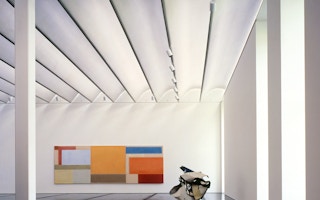More than 30 years ago, a handful of international architects and engineers put their heads together to hold collaborative workshops where they could create designs that were both beautiful and multi-functional. The results included uniquely sustainable buildings such as the Menil Collection and the Nasher Sculpture Centre in Texas, US, designed by architectural practice Renzo Piano Building Workshop and professional services firm Arup.
These buildings were held up at the International Green Building Conference on Tuesday as examples of how integrated thinking – getting professionals from all parts of the industry to work together on all phases of a project – can advance the sustainability movement.
“Our ambition together was to make a single element that performed many functions,” said Mark Carroll, senior partner with Renzo Piano Building Workshop, who co-presented a talk on collaborative integrated design at the event’s closing plenary session. Describing how that common interest led to repeated successes, he said that integrated thinking, in his experience, hinges on giving people a sense of joint participation and belonging.
Balancing specialisation with a holistic view
Carroll’s co-presenter Alistair Guthrie, Arup’s global sustainable buildings design leader and a major figure in the Renzo Piano-Arup collaboration, noted that despite the importance of integration, the industry has become increasingly specialised.
As an example, he pointed to how the growing number of special consultants can lead to as many as 20 different experts working on a single project.
“That is good because you have more experts, but at the same time, it is very hard to integrate them into a project that is a whole,” he said.
Aside from making integrated thinking difficult, excessive specialisation has caused too much duplication and protectionism in the design industry, which ultimately harms sustainable practices, warned architect Tai Lee Siang, the secretary of the World Green Building Council.
He pointed out that while designers may say they support sustainability, all too often when a tender is called they are more concerned about beating the competition than about ensuring their project is sustainable.
“We are not taught to work together. Since university, we are taught to segregate our tasks and responsibilities,” he said. “This has led to blind spots in design that will slow down the green building movement.”
Nevertheless, speakers agreed that addressing this does not mean removing specialisations or to make professionals learn all the trades. A balance between the two must be struck.
“In my company, one of the things that we want to encourage is people to be integrators,” said Guthrie, explaining that professionals – regardless of their specialisation – need to acquire a broader perspective on how their role fits into the larger project. “It’s not just about people who can tick the boxes, it’s about understanding what it means for the whole project.”
“
Many of our buildings will be around for 50 years or more, so let’s take a bit of time to set the design in the right direction
Alistair Guthrie, global sustainable buildings design leader, Arup
Bringing the industry and end users together
“We look at sustainability as something where the whole industry has to work together,” said Er. Lam Siew Wah, the Building and Construction Authority’s deputy CEO of industry development.
Describing the mindset behind Singapore’s third green building masterplan - a blueprint guiding the country’s strategy to grow the number of sustainable buildings - he explained that whereas the previous two masterplans had been technical in their approach, the third version targets building users as they have to be involved in order to improve the performance of buildings here.
“We asked ourselves when we drafted the third masterplan: why are we doing green buildings? Green buildings are occupied by people. What’s in it for them?” he said.
In recognition that more can be done to equip the operators of green buildings, BCA is introducing new Green Mark courses for facilities management professionals. Er. Lam pointed out that to date, only 500 facilities management professionals have been trained in these courses compared to over 2,500 design management professionals. There is now a need to balance the numbers, he added.
While BCA has the advantage of being able to move the whole industry through legislation, other speakers noted that the industry must also play its part.
Tai, who is also managing director of international architecture firm Ong & Ong, said that there is a need to rethink areas such as procurement methodology and how teams of consultants are assembled. Companies may need to restructure, he warned, adding that he has already done so with his own firm, making all professionals work together to deliver sustainable results regardless of whether they are labelled ‘architect’ or ‘engineer’.
Building owners also need to have more ambitious sustainability goals, said speakers. Er. Lam pointed out that while the government does its part by setting minimum standards, the best initiator of integration is still the client. “If the owner tries it, everyone will come together. We need more leaders among clients to drive sustainability,” he said.
Often, this requires firms to engage and encourage their clients, said Arup design leader Guthrie. “We want to encourage clients to imagine what is possible, and in order to do that, we as the experts in the design profession have to help the clients who are not specialised,” he explained. “In my experience, many clients are very interested to change their approach and be progressive, but they really need our help.”
Ultimately, integrated thinking in sustainability is about working together to determine the future, and the payoff is more than worth the effort involved, said Guthrie. “Many of our buildings will be around for 50 years or more, so let’s take a bit of time to set the design in the right direction,” he advised.
Our special event coverage of the International Green Building Conference 2014 is brought to you by City Developments Limited (CDL).













